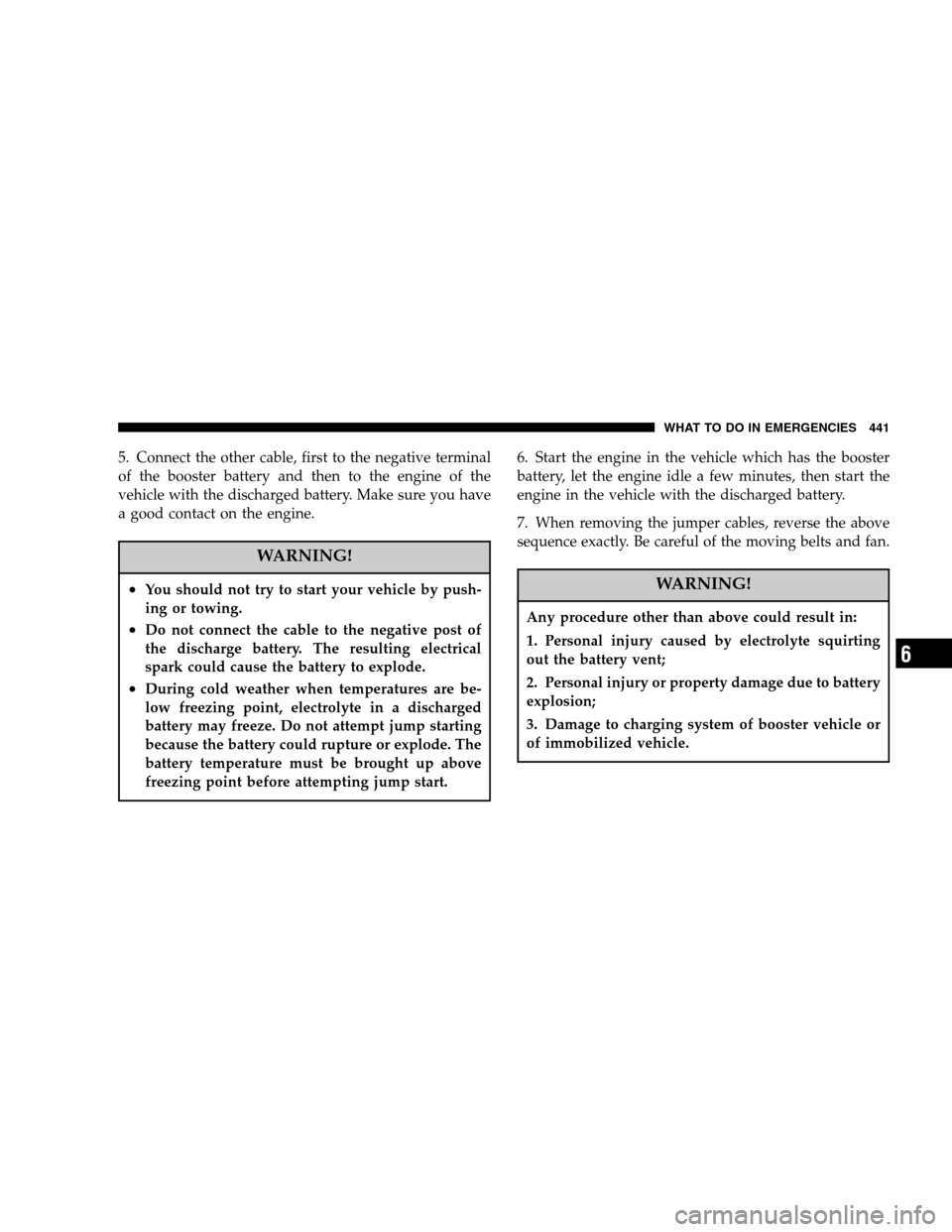Page 427 of 568

It is recommended that you stow the flat or spare to
avoid tangling the loose cable.
NOTE:The winch mechanism is designed for use with
the jack extension tube only. Use of an air wrench or other
power tools is not recommended and can damage the
winch.
Tire Changing Procedure
WARNING!
Getting under a jacked-up vehicle is dangerous. The
vehicle could slip off the jack and fall on you. You
could be crushed. Never get any part of your body
under a vehicle that is on a jack. Never start or run
the engine while the vehicle is on a jack. If you need
to get under a raised vehicle, take it to a service
center where it can be raised on a lift.
Do not raise this vehicle using a bumper jack. The jack is
designed as a tool for changing tires on this vehicle only.
It is not recommended that the jack be used for service
purposes or to lift more than one wheel at a time.
Preparations
Park the vehicle on a firm level surface, avoiding ice or
slippery areas. Set the parking brake and place the gear
selector in PARK (automatic transmission) or REVERSE
(manual transmission). On four-wheel drive vehicles,
shift the transfer case to the “4L” position.
WARNING!
Do not attempt to change a tire on the side of the
vehicle close to moving traffic. Pull far enough off
the road to avoid the danger of being hit when
operating the jack or changing the wheel.
WHAT TO DO IN EMERGENCIES 427
6
Page 428 of 568
•Turn on the Hazard Warning Flasher.
•Block both the front and rear
of the wheel diagonally oppo-
site the jacking position. For
example, if the right front
wheel is being changed, block
the left rear wheel.
•Passengers should not remain in the vehicle when the
vehicle is being jacked.
Instructions
WARNING!
Carefully follow these tire changing warnings to help
prevent personal injury or damage to your vehicle:
•Always park on a firm, level surface as far from the
edge of the roadway as possible before raising the
vehicle.
•Block the wheel diagonally opposite the wheel to
be raised.
•Apply the parking brake firmly before jacking.
•Never start the engine with the vehicle on a jack.
•Do not let anyone sit in the vehicle when it is on a
jack.
•Do not get under the vehicle when it is on a jack.
•Only use the jack in the positions indicated.
•If working on or near a roadway, be extremely
careful of motor traffic.
428 WHAT TO DO IN EMERGENCIES
Page 441 of 568

5. Connect the other cable, first to the negative terminal
of the booster battery and then to the engine of the
vehicle with the discharged battery. Make sure you have
a good contact on the engine.
WARNING!
•You should not try to start your vehicle by push-
ing or towing.
•Do not connect the cable to the negative post of
the discharge battery. The resulting electrical
spark could cause the battery to explode.
•During cold weather when temperatures are be-
low freezing point, electrolyte in a discharged
battery may freeze. Do not attempt jump starting
because the battery could rupture or explode. The
battery temperature must be brought up above
freezing point before attempting jump start.
6. Start the engine in the vehicle which has the booster
battery, let the engine idle a few minutes, then start the
engine in the vehicle with the discharged battery.
7. When removing the jumper cables, reverse the above
sequence exactly. Be careful of the moving belts and fan.
WARNING!
Any procedure other than above could result in:
1. Personal injury caused by electrolyte squirting
out the battery vent;
2. Personal injury or property damage due to battery
explosion;
3. Damage to charging system of booster vehicle or
of immobilized vehicle.
WHAT TO DO IN EMERGENCIES 441
6
Page 442 of 568

FREEING A STUCK VEHICLE
If vehicle becomes stuck in snow, sand, or mud, it can
often be moved by a rocking motion. Move the gear
selector rhythmically between DRIVE and REVERSE
(automatic transmissions) and between 1st and RE-
VERSE (manual transmissions), while applying slight
pressure to the accelerator.
In general, the least amount of accelerator pedal pressure
to maintain the rocking motion without spinning the
wheels or racing the engine is most effective. Racing the
engine or spinning the wheels, due to the frustration of
not freeing the vehicle, may lead to transmission over-
heating and failure. Allow the engine to idle with the
transmission selector in NEUTRAL for at least one
minute after every five rocking-motion cycles. This will
minimize overheating and reduce the risk of transmis-
sion failure during prolonged efforts to free a stuck
vehicle.
EMERGENCY TOW HOOKS — IF EQUIPPED
Your vehicle may be equipped with emergency tow
hooks.
NOTE:For off-road recovery, it is recommended to use
both of the front tow hooks to minimize the risk of
damage to the vehicle.
WARNING!
Chains are not recommended for freeing a stuck
vehicle. Chains may break, causing serious injury or
death.
442 WHAT TO DO IN EMERGENCIES
Page 445 of 568
MAINTAINING YOUR VEHICLE
CONTENTS
�Engine Compartment— 3.7L/4.7L...........448
�Engine Compartment— 5.7L...............449
�Onboard Diagnostic System (OBD II).........450
▫Loose Fuel Filler Cap Message............450
�Emissions Inspection And Maintenance
Programs............................451
�Replacement Parts......................452
�Dealer Service.........................453
�Maintenance Procedures..................453▫Engine Oil..........................454
▫Engine Oil Filter......................457
▫Drive Belts — Check Condition And Tension . . 458
▫Spark Plugs.........................458
▫Spark Plug Wires.....................458
▫Engine Air Cleaner Filter................459
▫Engine Fuel Filter.....................459
▫Catalytic Converter....................459
▫Emission-Related Components............461
7
Page 447 of 568

▫Noise Control System Required Maintenance &
Warranty For 3500 2-Wheel Drive And 4-Wheel
Drive Models Over 10,000 Lbs. (4 535 Kg)
Gross Vehicle Weight Rating..............483
▫Appearance Care And Protection From
Corrosion...........................487
�Fuses (Integrated Power Module)...........492
�Vehicle Storage........................497
�Replacement Light Bulbs.................498
�Bulb Replacement......................499
▫Headlight (Halogen)/Front Park And
Turn Lights.........................499
▫Fog Lights..........................502
▫Tail, Stop, Turn And Backup Lights.........503▫Center High-Mounted Stoplight (CHMSL)
With Cargo Light.....................506
▫Cab Top Clearance Lights — If Equipped....507
▫Tailgate ID Lights (Dual Rear Wheels) —
If Equipped.........................509
▫Rear Light Bar ID Marker (Dual Rear Wheel) –
If Equipped.........................510
▫Side Marker Lights (Dual Rear Wheels)......511
�Fluids And Capacities...................512
�Fluids, Lubricants And Genuine Parts........514
▫Engine.............................514
▫Chassis............................515
MAINTAINING YOUR VEHICLE 447
7
Page 448 of 568
ENGINE COMPARTMENT— 3.7L/4.7L
448 MAINTAINING YOUR VEHICLE
Page 449 of 568
ENGINE COMPARTMENT— 5.7L
MAINTAINING YOUR VEHICLE 449
7